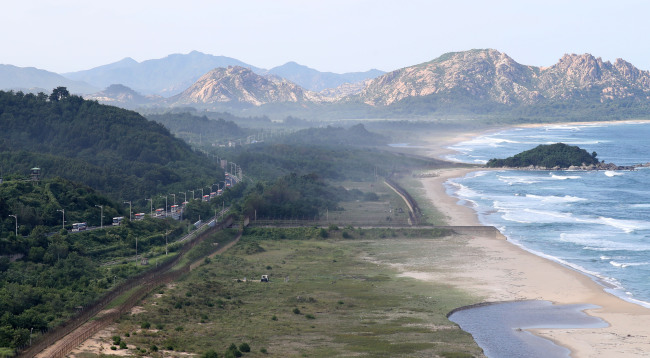The leaders of the two Koreas on Wednesday vowed to revive the now-suspended tours to North Korea’s eastern slopes of Kumgangsan and bolster humanitarian cooperation with the establishment of a permanent meeting area for families separated by 1950-53 Korean War.
“The South and North have decided to negotiate normalizing the Kaesong industrial complex and tour programs to Kumgansan and the issue of forming a special joint economic zone near the West Sea and a joint tourism zone near the East Sea, once the right conditions are established,” read a joint statement signed in Pyongyang by South Korean President Moon Jae-in and North Korean leader Kim Jong-un during their summit.
 |
Kumgangsan (Joint Press Corps) |
Coupled with the now-shuttered Kaesong complex, the Kumgangsan tour program was believed to be one of the main sources of hard currency for North Korea when it was suspended in 2008. The program was halted after a South Korean tourist was shot dead by a North Korean guard.
Hyundai Asan, the inter-Korean business arm of South Korean conglomerate Hyundai Group, which has the exclusive rights to operate the tours, invested about 500 billion won ($440 million) in the tour project which kicked off in 1998.
Skeptics, however, pointed to the lack of specific dates in the agreement, along with layers of sanctions in place against the communist nation, as stumbling blocks on the road to full-blown cross-border economic cooperation.
“Regarding agreements that concern economic cooperation, the lack of a specific timeline or due date means nothing is certain,” said Cho Han-bum, a senior researcher at the Korean Institute for National Unification.
“North Korea may want to see progress in economic cooperation, but it will not see clear progress by the end of the year unless sanctions are lifted.”
Washington has reiterated that inter-Korean relations must advance in tandem with progress in the North’s denuclearization.
Regarding the issue of families separated by the 1950-53 Korean War, the two Koreas agreed to launch a permanent facility for reunions at the earliest possible date. They also pledged to hold a Red Cross meeting to arrange reunions via video chats and the exchange of video messages.
The two Koreas held family reunions at Kumgangsan last month where more than 600 South Koreans met their long-lost families living in the North, as part of measures to implement the Panmunjom Declaration reached between Moon and Kim in April.
To bolster cross-border sports and cultural exchanges, the two sides agreed to cooperate for the 2020 Tokyo Summer Olympics and to make efforts to bid to co-host the 2032 Summer Olympics.
US President Donald Trump tweeted, “North and South Korea will file a joint bid to host the 2032 Olympics. Very exciting!” following the release of the statement from Pyongyang.
Last week, the International Olympic Committee spokesperson Mark Adams told Radio Free Asia that the organization is willing to support the two Koreas if they should push for a joint hosting of the 2032 Olympics.
The two Koreas have been increasing sports exchanges, following the North’s participation in the 2018 PyeongChang Winter Olympics. They formed unified sports teams and made joint entrances under the Korean Unification Flag at both PyeongChang and the 2018 Jakarta-Palembang Asian Games last month.
A North Korean art troupe will perform in Seoul in October, which is seen as a reciprocation of the two performances involving South Korean musicians held in Pyongyang in April.
The two sides also agreed to strengthen cooperation and exchanges in the medical and health sectors, and to host a joint ceremony to mark the centennial of the March 1 independence movement next year.
By Jung Min-kyung & Joint Press Corps (
mkjung@heraldcorp.com)








